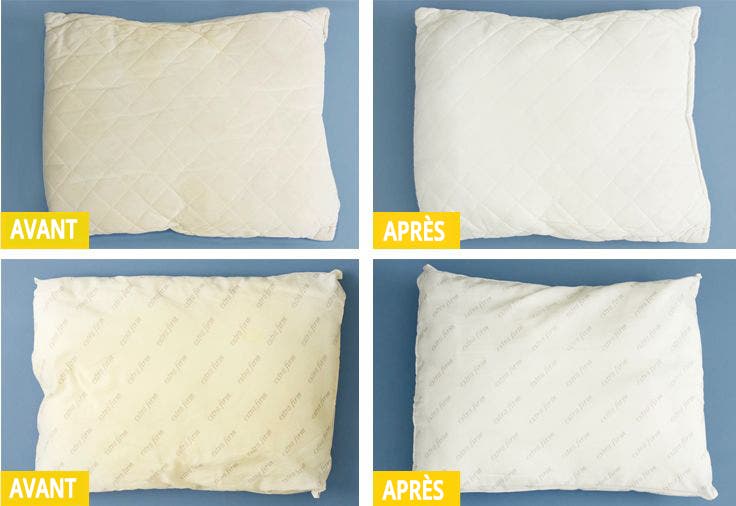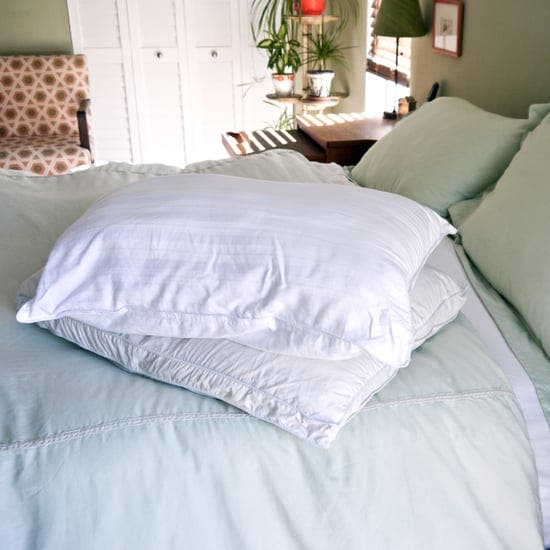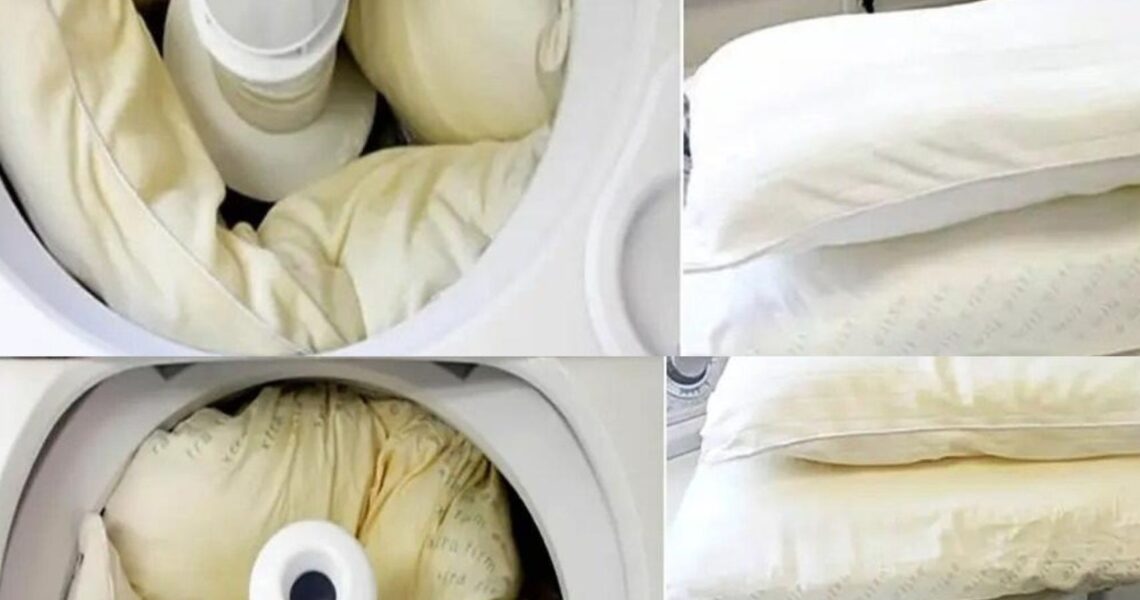How to wash yellowed pillows: 3 tips to make them white like new
If your duvets and pillows have a yellowed appearance, it is only natural. Over time, various factors such as dust mites or sweat affect the quality of the bedding. Luckily, it’s possible to make yellowed pillows snow-white with the right tricks. Discover three simple and effective washing methods as well as some practical tips for always clean laundry.
As you must know, everything related to bedding should be washed regularly, and pillows are no exception to this rule. It is indeed important to disinfect them and remove any yellowish stains that have settled there.
Plus, pillows can easily become an environment that encourages dust mites, viruses and bacteria. These come, among other things, from sweat and dirt particles that form there over time. But despite the yellowish stains and odors that can come from your pillows, it’s not always necessary to throw them away. This is even more true if they are of good quality and have not exceeded a lifespan of 2 years.
Before taking such measures, focus instead on inexpensive cleaning tips to keep them looking better. Here are some methods you should use once a month to treat it effectively. These also apply to pillows and neck rolls.
What causes yellowing pillows?
As you can already imagine, the main and most common reason remains sweating. And for good reason, because of the latter, your pillow will gradually and irrevocably turn yellow every night. Body sweat penetrates the fibers of the pillow before subsequently appearing on the surface. But although sweat remains the most common cause, other factors also play a role, such as saliva.
The fluids we secrete contribute to the yellowing of the pillow that absorbs them. In addition, this discoloration is not only an aesthetic problem, as it is evidence that bacteria and mites have settled in the heart of the fibers. And it’s completely natural, as these creatures are particularly fond of spreading moisture, which can lead to conditions such as asthma, allergies or rhinitis.

Pillow before and after washing – Source: onegoodthingbyjilee
Here are 3 effective methods to wash your yellowed pillows:
1. Hot water and lemon
Lemon is an invaluable and very effective ally if you want to give new life to your pillows to sleep well and with optimal comfort. You can use the following trick to take advantage of the whitening and disinfecting properties of citrus fruits.
Start by boiling 2.5 liters of water and add 6 glasses of lemon juice. Then soak the pillow in this lemon water for about 2 hours. All you need to do is wash the pillow with soapy water to remove stains before rinsing and drying it. Feel free to add more water so that the pillow is completely submerged in the solution.
2. White vinegar and baking soda
To naturally lighten and soften the textile fibers of your pillow, a combination of baking soda and white vinegar is a perfect solution. You can in fact rely on the antibacterial and whitening effects of these two elements to remove all the dirt, sweat and stains on the pillow. In addition, this also helps combat any bad odors that may have stuck in it.
To use them well it is very simple. Place your pillow in a basin filled with hot water and add 1/2 cup of white vinegar mixed with an equal amount of baking soda. Allow to soak for 1 hour. Then select a normal wash cycle and run it through the washing machine, then air dry. It should be noted that baking soda can also be used to clean your mattress.
3. Lemon and hydrogen peroxide
Ideal as a replacement for bleach, this anti-stain and anti-mite treatment consists of the combination of lemon juice and hydrogen peroxide (oxygenated water) to whiten linen. Ingredients containing active ingredients that can easily remove sweat or saliva stains.
To reap its benefits, prepare a bucket of hot water into which you add half a cup of lemon juice and double the amount of hydrogen peroxide. Place the pillow in the bucket and let it sit for an hour. When this time is up, run a normal cycle in your washing machine to rinse the pillow and then let it dry in the sun.
Practical tips for washing your pillows
To ensure optimal washing of pillows, it is important to take into account a number of recommendations:
- Always read the label: Whether polyester, cotton or feather, any type of pillow should be washed according to the label’s washing instructions to maintain its quality. So always check if yours is machine washable.
- For top-loading machines: Take two pillows at a time to keep the machine balanced.
- Air dry or sun dry: When you’re done washing, simply place your pillows in the sun so they can benefit from the UV rays. The latter promote fading of the textile, making this light source the best way to dry your bed linen while making it easier to eradicate dust mites. Result: You will find a bright white pillow so you can sleep peacefully at night.
If you choose to tumble dry, opt for a fresh air cycle. If it’s a feather pillow, add tennis balls to make it look stuffed. However, be careful not to put more than two at risk of damaging the device’s drum.

Ear Care – Source: Pop Sugar
3 tips for caring for your pillows
In addition to washing, it is equally important to take preventive and useful measures for the proper care of pillows to keep them soft, clean and comfortable:
1. Use a pillow protector
They can give your pillow a second line of defense against dead cells, sebum or sweat secreted by the skin. All you need to do is get a pillow protector to place under your pillowcase to keep allergens from getting in. Also make sure to wash these covers every month.
2. Wash pillows 3-4 times a year
This is even more true if you notice that they are yellowing. As for the pillowcases, which are obviously the first to be exposed to our bodily fluids, once or twice a week is a correct frequency.
3. Replace cushion after 2 or 3 years
While many people keep their pillows for a particularly long time, it’s best to replace your pillows after 2 or 3 years of use. In fact, after a while, pillows lose their firmness and can no longer support your head properly. However, their yellowing should not always be a reason to replace them.
How are the pillows washed depending on the type?
Depending on the filling of your pillows, washing instructions vary. Here’s what you should do with each type:
- Memory Foam Pillow: Given the risk of the washing machine damaging the foam filling and the viscoelastic behavior of your memory foam pillow, it may be preferable to opt for hand washing. You need to start by submerging it completely in water and squeezing the pillow for 10 minutes. Then rinse until the water runs clear, making sure to wring it out thoroughly before air drying. If stained, clean with a damp cloth moistened with a small amount of mild detergent or stain remover. Result: a firm pillow, ideal for supporting the spine.
- Polyester Pillow: For this type of synthetic fiber pillow, wash it in lukewarm water on a gentle cycle. The amount of detergent should be sparing. For machine washing, one to two teaspoons are enough.
- Feather or goose down pillows: Place these pillows in the washing machine with cold water and a mild detergent. Then tumble dry on low heat to avoid damaging the down. The quality of the latter can deteriorate due to high temperatures.
What about bedding and how often should it be washed?
The bedroom is a place with humidity and heat, which are perfect conditions for the accumulation of bacteria, germs and other dirt. To avoid these inconveniences, it is necessary to wash the sheets and duvet cover every two weeks or even every week. There are also natural solutions to effectively clean your mattress.
How do you wash your bed linen correctly?
Bedding sets and sheets should be washed regularly so that you can always enjoy fresh-smelling bedding. It is therefore advisable to wash them at the right temperature and prefer warmth. It is in fact a high temperature that eliminates any pathogens that have managed to nest in the microfibers of the sheets. However, always check the recommended temperature on the label. This will help you not to compromise the quality of your laundry.
